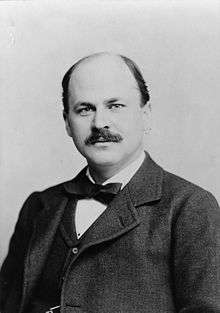William Henry Baldwin Jr.

William Henry Baldwin Jr. (February 5, 1863 – January 3, 1905) was a president of the Long Island Rail Road from Boston, Massachusetts. He graduated from Harvard University in 1885 and studied law there for a year afterward. He was instrumental in establishing African American industrial education by securing sizable donations from Northern industrial magnates. Baldwin became a trustee of Tuskegee University in 1894 where he worked alongside Booker T. Washington. The son of a prominent Bostonian, William Henry Baldwin Sr., he carved out a successful career for himself in the railroad industry and gave generously of his time and money to the education of former slaves.[1]
Railroad career
His railroad career began through an invitation from Charles Francis Adams, president of the Union Pacific Railroad. Baldwin started as an auditor's clerk in the Omaha, Nebraska office. He rose successively to general agent for the Montana territory, assistant general freight agent for Union Pacific, and manager of the railroad's Leavenworth, Kansas, division.
In 1891 Baldwin found employment with Flint and Pere Marquette Railway, where he remained for two years. He then became the third vice president of the Southern Railway system. One of his challenges was the reorganization of the Richmond and Danville railway lines. In a couple of years he was promoted to second vice president and general traffic manager. His efforts enabled the Southern Railroad to avoid bankruptcy.
Work for African American Education
Baldwin was an original trustee of the Southern Education Board and became the first president of the General Education Board in 1902. His work at Tuskegee was considered so important that during the 25th anniversary ceremonies his name, along with Andrew Carnegie's and President William Taft's, was inscribed onto the lawn in letters several feet long.
Personal
On October 30, 1889, Baldwin married Ruth Standish Bowles, of Springfield, Massachusetts.[2]:68 They had three children: Ruth Standish (born August 8, 1890); William Henry III (born September 17, 1891); Mary Chaffee (1896–1897).[2]:68 Mrs. Baldwin joined him in his work for African American education, and was one of the founders of the National Urban League in 1910. Their daughter Ruth married the landscape painter John Fulton Folinsbee.
Baldwin died of intestinal cancer at his home in Locust Valley, New York in 1905. He was buried in Forest Hill Cemetery in Boston following a private funeral in Glen Cove, New York. After his death the ferries operated by the Long Island Railroad flew their flags at half mast and the principal stations on the road were draped in black for several days.[3][4]
References
- ↑ Brooks, John Graham, "An American Citizen: Life of William Henry Baldwin Jr." (Houghton Mifflin, 1910).
- 1 2 John Graham Brooks, An American Citizen: The Life of William Henry Baldwin, Jr., (Boston and New York: Houghton Mifflin Company, 1910).
- ↑ W.H. Baldwin At Last Succumbs To Malady, New York Times, January 4, 1905, pg. 9.
- ↑ "Thousands Pay Tribute to William H. Baldwin," New York Times, January 12, 1905
Anderson, J. (1988). The Education of Blacks in the South, 1860-1935. (pp. 79–109). Chapel Hill, NC: University of North Carolina
External links
| Preceded by Austin Corbin |
President of Long Island Rail Road 1896 – 1905 |
Succeeded by William F. Potter |